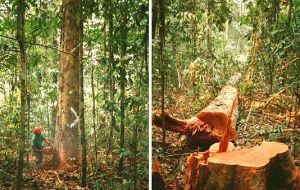MercoPress. South Atlantic News Agency
Uruguay's forests ready for the fourth pulp mill project
 Portucel announced its interest in a new pulp mill of one billion US dollars
Portucel announced its interest in a new pulp mill of one billion US dollars Uruguay is on route to add another substantial option to its commodities' led economy: pulp and paper. A pulp mill is ready to begin production, another two are on the drawing board and a fourth has been announced by Portuguese interests.
The Botnia Orion plant originally from Finland and which demanded an investment in the range of 1.5 billion US dollars is undergoing trials and is scheduled to begin production in the coming weeks in spite of the Argentine government and pickets' ongoing opposition. A second pulp mill is to be built by Spain's ENCE, along the coast of the River Plate. Originally to be placed a few kilometers from Botnia-Orion on the river Uruguay, the plant was relocated following strong pressure from Argentina, but also for logistic reasons and a clean up process inside the company. Partly owned by the Spanish government Ence, according to the current Socialist administration, had too many cronies from the previous Conservative administration who committed several money loosing mistakes while waiting to be removed. The purge and improved relations with the financial sector should help move the project ahead keeping to the original timetable of 2009/2010, reports the Spanish press. The project is estimated to demand over a billion US dollars. Another project belongs to Sweden's Stora-Enso and is planned to be built in the center of Uruguay along the Rio Negro, a waterway which cuts the country in half (East/west) and is already dammed in three locations generating an average 30% of the electricity consumed in Uruguay. Finally during the recent visit of Uruguayan president Tabare Vazquez to Brussels, Spain and Portugal, the Lisbon seated company Portucel announced its interest in constructing a paper and pulp plant in Uruguay, somewhere in the east of the country and involving an investment in the range of one billion US dollars. The four projects underline the pro business atmosphere in Uruguay plus the natural conditions for such undertakings: abundance of water, trees and rainfall. Uruguay has a well irrigated territory with limited high productivity areas ideal for agriculture (cereals, oilseeds and forage) but also ample natural pastures for livestock, 12.5 million head of cattle and 15 million sheep, which help to make up most of the country's foreign trade. However, in the last twenty years Uruguay promoted forestry as an option for the poorest soils and now an estimated 800.000 hectares have been planted mostly with eucalyptus (80%) and the rest coniferous. An ideal input for the pulp industry. According to industry sources Uruguay still has room for another 500.000 hectares of forests, which if completed would mean 9% of the country's 16 million hectares of land will be dedicated to the new option for the country's economy. With a GDP in the range of 18 to 20 billion US dollars, four investments of such magnitude anticipate a significant change for the country's economy and development possibilities. All projects have the full support of the political establishment.




Top Comments
Disclaimer & comment rulesCommenting for this story is now closed.
If you have a Facebook account, become a fan and comment on our Facebook Page!